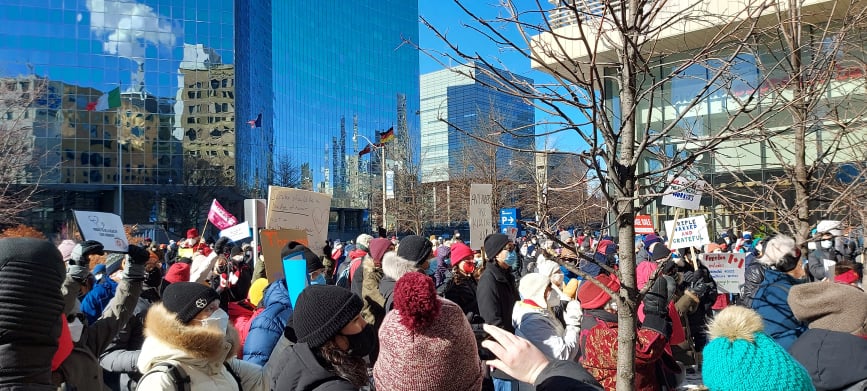
After two and a half years of the COVID-19 pandemic, thousands of people have died as a result of the virus and government mismanagement, with more than 41,000 deaths and 3.9 million cases across Canada so far. As the subvariants of Omicron now begin to take hold across the globe, working class people, exhausted and battered, are left unprepared for another wave of the virus, and Canada’s health-care system is in a state of collapse. Meanwhile, the bosses and their friends in government continue on as normal, happily making exorbitant profits. Jahan Niroomand, a labour organizer and writer for Fightback magazine, reached out to discuss the current state of the health-care system in Canada and how to move forward with physician Dr. Amit Arya.
Arya is an outspoken palliative care physician who works at hospitals in Toronto, and also in home care and long-term care. He co-signed a public letter in support of a protest with other physicians and nurses to oppose the so-called “Freedom Convoy” when it came to Toronto this past winter. He also belongs to the board of Canadian Doctors for Medicare and has faculty appointments at the University of Toronto and McMaster University.
Jahan Niroomand: I want to start off by discussing the current state of the health-care system in Canada as we continue to live under the COVID-19 pandemic. While nurses, doctors, and other workers face massive levels of exhaustion and cutbacks to their living standards, governments at all levels are failing the health-care system. How would you describe the current state of affairs?
Dr. Amit Arya: Our health-care system is under tremendous pressure at this point in time. This may be quite alarming and shocking to some. But personally, none of this comes as a surprise as the health-care system here in Canada has suffered for decades due to crushing austerity measures. In terms of the number of hospital beds in Canada, we rank near the bottom of the OECD. Ontario is dead last compared to other provinces in terms of hospital beds per capita, and also has a huge shortage of nurses—22,000 nurses short even before the COVID-19 pandemic. Needless to say, our underfunded, under-resourced, and understaffed health-care system was pummeled by wave after wave of the pandemic. Asking a system which is underfunded and the people working within it to be efficient and resilient can only continue for so long. And that is why we are at this critical point in respect to our health-care system.
Health care is a human right and should be properly funded in our country. We have the funds, we have the resources to do this. But yet, right now it is very disheartening when provincial premiers just point fingers at the federal government and we see this back and forth between politicians when they should all be coming together to fix a broken system and cooperate in the public interest. It is in the public good to fund the system properly and to end the influence of the for-profit private sector in health care.
JN: I definitely agree and my next question is to continue on this point. In the Toronto Star, you have said that: “Years of underfunding of our health system and social safety net have created a humanitarian crisis that is still ongoing.” Can you elaborate on this?
AA: I wrote that because what makes us sick is mostly social. At least 50 per cent of what makes us sick is determined by the social factors that influence health, e.g. poverty, disability, food insecurity, homelessness, and racism. All of these social determinants of health have been exacerbated during the COVID-19 pandemic. People have been made vulnerable by the policy failures of our government.
JN: Yes, and we currently live under a profit-driven system, called capitalism.
AA: Absolutely.
JN: A system where corporations are at fault for the crisis as they have profited off billions in handouts from governments while working class people see their living standards decline. This has been happening before the pandemic, and now even more so during the pandemic. And with the rise of inflation, the economy is worsening. So my next question is, where do we go from here with what you just outlined?
AA: Lower-wage workers were left to die during the COVID-19 pandemic because of lack of paid sick days; because of wages that did not keep pace with inflation, which meant that many people could not afford groceries and rent. And the data supports this.
Through all the different waves of the pandemic, including the Omicron waves, lower-income communities, where many essential workers (many of whom belong to racialized or immigrant populations) live, had a significantly higher mortality rate due to COVID-19. Shortening the isolation requirement for COVID from 10 days to just five days, along with completely inadequate paid sick days shows us that essential workers were just called “essential”, but were actually only valued for their labour, not their health. In earlier waves, vaccines were actually diverted away from many lower-income, racialized communities, when they were on fire with COVID-19! Diverted away from those communities when people were dying en masse and there was a humanitarian crisis.
So many people had to go to work, even when it was unsafe, because they were afraid of losing their jobs or they were afraid of not meeting expenses like grocery bills and rent. At one point, my ICU/emergency department colleagues were intubating one patient per hour, and most of these patients got COVID-19 from their workplace. I will never, ever forget the anguish and moral distress that went into providing end-of-life care for a low-wage worker, or their family member, who died because of a lack of paid sick days.
Overall, the COVID-19 pandemic has shown us how the government does not care about lower-income communities and workers. There was a recent Toronto Star analysis which showed that even in the most recent Omicron waves, lower-income neighborhoods—where we know more racialized people are living, where more essential workers live—have continued to be disproportionately impacted by COVID-19. Whether you’re someone who lives with a disability in long-term care, or someone who is unfortunately suffering from long COVID because your employer and the state did not provide you with safe working conditions, your life is no longer valued because you cannot contribute to the economy. So the government will no longer provide you with the necessary support to even survive.

Her death was an example of what Engels called ‘social murder’
JN: This reminds me of a term that Friedrich Engels used to describe the actions of capitalist governments, that it is social murder. That they could have done things to save people’s lives, but they chose not to in the interest of profit.
AA: Yes, absolutely. And to answer your question about, where do we go from here and what do we do next? I think there are specific health-care and COVID-related recommendations that I can provide to you.
Firstly, we need to recognize that the pandemic is not over. The progressive left needs to organize around disability rights and justice for all workers. Allowing our government to pull the wool in front of our eyes and tell us that COVID is no longer a relevant illness is far from the truth. In fact, even with vaccinations, our death rate this year in the pandemic is higher than in 2021 or in 2020. Why? It’s not because vaccines don’t work, but it’s because our governments don’t want to spend the money required to protect us: a huge indictment of our capitalist system. When Omicron hit, they couldn’t pause the economy even if it was just for two weeks in order to protect people who were the most vulnerable. This is because the focus was on short-term profits and getting people back to work, regardless of the consequences of what this would do to people’s health. They just let COVID rip in communities that were already vulnerable, without even basic protections like N95 masks. Even though the pandemic is completely driven by socioeconomic factors, it is shocking that we have never really had an equity-informed approach to COVID-19.
As was said, specific communities of people have been made vulnerable by longstanding policy failures and have been impacted ever so much by COVID-19, whether it is essential workers, racialized communities, people who live in long-term care. So for example, we could have of course prioritized these communities for vaccines in earlier waves. We could have also provided everyone with N95 masks for free. This is even something that Biden has done in the U.S.—he has distributed N95 masks for free to the general public. So why is Canada not doing this at this point in time? And thinking beyond the pandemic, is this also not an opportunity to end austerity measures and underfunding of our health-care system and social system? Is it also not the opportunity to create legislation for Medicare version 2.0 that will include pharmacare, vision care, dental care, long-term care, home care, palliative care? These are all essential services that should be adequately funded and resourced by our government.
Now in terms of what we do next, I want to say that many of my colleagues and friends are starting to feel hopeless. They are starting to fall into despair and cynicism. The reason? For a long time people have relied upon our current electoral system to make change at the ballot box and relied upon the political class to make these changes. What we see now in Canada, with the rise of the far-right and the so-called “Freedom Convoy”, is that there is power in being organized. And we need dedicated groups of people, even people who are fanatical to force the changes that are needed on the progressive left. People that will show up every single day to support our health-care system and move the levers of democracy to end economic austerity
JN: Speaking of the Freedom Convoy, when they came to Toronto, there was a protest organized by you and other nurses and physicians. This was really the only mobilized contingent against the convoy on the streets here in Toronto. Some of our activists with Fightback attended, and we were really pushing for the rest of the labour movement to come behind you. We were inspired by your mobilization, but the labour movement could have given the leverage needed to show the far right and the right populists that their movement is not welcome.
Following that, the NDP came out with the idea of putting long-term care homes under public ownership, and some would criticize that plan as too late and not as comprehensive. Fightback has called for expropriation of long-term care homes under democratic workers’ control so that the workers that are actually running them on different levels would be able to control them and separate it from the for-profit system. And to get there, to strike and mobilize on the streets and in the workplaces for public ownership, for fair wages and safer working conditions and further.
AA: You might be surprised to hear this, Jahan, but I will explain my philosophy around this: we need to abolish long-term care institutions. Long-term care is a system that originates from the penal system, not the health-care system. It was derived from Canada’s colonial history. In colonial England there were Victorian poor houses where people that were deemed to be undesirable—whether disabled, older or living in poverty, and even unwed mothers—were separated from society and put into these “homes”. I don’t call them homes anymore, they are not homes—I call them facilities or institutions.
The fundamental problem with this ableist system is that care can only be provided to you contingent on the fact that you have to be separated from society. Our population is aging rapidly and as a part of this, we don’t need more long-term institutions. We cannot simply build our way out of the elder care crisis—a policy which benefits developers and for-profit long-term care corporations. We can actually provide people care in their own community, in their own home, and start by recognizing housing as a human right. In fact, when we refer to “home care”, the inequity is actually baked into the term itself, because not everybody has a home.
So first, we need to provide housing as a human right to everyone. Older adults are actually the fastest-growing demographic group that is experiencing homelessness. Housing is health care. Second, we need to provide adequately funded care to people in their own homes and improve the working conditions for the workers providing this care. Third, if we do have congregate living, it should be based on a household model which means you are living in a home, perhaps with five or 10 other people who belong to the same culture and share similar values. Once again, we do not need to have 200 or 300 people warehoused together under a single roof to provide care! As I mentioned before, this policy will primarily benefit developers. It is far more expensive to the taxpayer because we need to purchase the land, and also spend billions to construct these huge institutions. The whole concept of long-term care needs to change. Long-term care should be a verb and not a place. Even now, there are a significant proportion of people living in long-term care who can be deinstitutionalized, and instead live in the community.
As a palliative care physician who has discussions around long-term care on a regular basis with patients and families, I’ve yet to hear someone who has actually wanted to go into long-term care. And the data supports this: a survey from the National Institute of Aging shows that 96 per cent of seniors want to avoid long-term care for as long as possible.
The only reason people are admitted into long-term care institutions is because no other options are available. It’s a coercive choice. Our government is purposefully underfunding other areas of the health-care system like home care and socialized housing, in order to benefit developers and for-profit corporations into building more of these long-term care facilities.
JN: You have the knowledge and those who are doing the work, seeing the issues firsthand, should have a say on how things should be organized, even on a political level. We’ve seen the NDP come out with the idea of nationalization, and Fightback further calls for the expropriation away from the capitalists and nationalization by a workers’ government under democratic workers control. You see capitalism as a for-profit system. Then the task is to take away power from the top—to take this power back through socialist policies in the labour movement and politically.
AA: As I mentioned, I identify as a LTC [long-term care] abolitionist. And the negligent LTC system is directly linked to the exploitation of front-line health workers. As someone who directly worked in long-term care through the first and second waves of the pandemic during large scale COVID-19 outbreaks, I worked alongside PSWs [personal support workers] who were begging me for personal protective equipment. But they were asked [by authorities] to reuse their masks. All of these long-term care facilities were for-profit and what was so distressing, while this humanitarian catastrophe was happening in their own facilities, these corporations continued to pay out shareholder dividends. They [corporations] also received the wage subsidy from the federal government and then turned around and maintained their shareholder dividends or even increased them. And they continued to pay bonuses to their CEOs and executives.
Some time ago, right here in Ontario, there was an outbreak that started in a shelter because there were two PSWs that were living in the shelter. The PSWs did not have enough money for housing, but they were going to work in a long-term care facility and that’s how they brought back COVID-19 in the shelter, which led to the outbreak. This shows you how dangerous and absurd the system is. Any profits generated should never have been provided to shareholders or executives, but they should have been provided to the front-line health workers and caregivers.
In long-term care, the majority of health workers (who are underpaid) and family caregivers (who are unpaid) are women. This opens up the topic of reproductive labour, and how caregiving is often devalued and seen as “women’s work.” If we had a system that returned profits to frontline health workers and caregivers, our system would be so much better.
JN: Any final thoughts for our audience?
AA: There are some organizations that are health-care and labour-focused that I recommend. These organizations include Health Providers Against Poverty, the Migrant Workers Alliance for Change, the Decent Work and Health Network, and Canadian Doctors for Medicare.
Beyond these organizations, what we urgently need is an organized and united people’s and worker’s movement to counter the rise of the extreme right in Canada.

JN: I agree and I think we need to mobilize within the labour movement and broader areas of society against this. We’re seeing the right populists use the Freedom Convoy to shut down streets, when it should be the other way around for the left to implement these tactics and for different demands.
AA: There is definitely a lot to speak about here. But I will end my comments by saying that historically, some of the positive social changes that have been achieved in the 1960s, 1970s, were actually through disruptive and even illegal protests from the progressive left. Whether it was civil rights, women’s rights, or anti-war protests, we need that same energy, that same ability to organize, and put aside our differences to unite at this time. There is no time for despair.
With the pandemic nightmare of COVID-19 continuing and the world economy showing signs of a global economic recession, Fightback is organizing in workplaces and communities across Canada to bring a socialist perspective to the struggle against capitalism. Join us!


